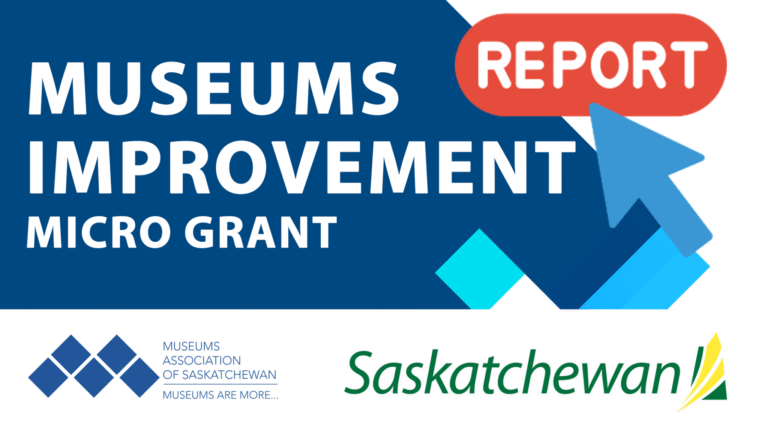
The MAS office will be closed for Christmas Holidays December 24th to January 4th.
Usual office hours will resume on January 5th, 2026
By: Kathleen Watkin, MAS Advisor
In order for a collection inventory to be successful it must be an institutionally wide priority. Your museum needs to have an up-to-date Collections Management Policy. This will ensure that you have standard guidelines for all aspects of your collections including but not limited to acquisition, disposal, handling, access to collections, storage, insurance procedures and records of collection activities, including when the records were made, up-dated and maintained.
Determining the Scope of the Inventory:
You need to determine what information you want to gather through this inventory process. Are you going to be ensuring that all artifact records have general condition reports or detailed measurements? Are you going to set out to fill in all the missing information from the basic accessing form? Whatever, you scope you choose, at the bare minimum these four fields should be filled in and updated:
Additional information you should HIGHLY consider updating and/or adding to the record include:
Planning Assumptions
You need to evaluation what resources are available and what your constraints are when conducting the inventory. Questions to consider:
You need to consider the logistical side of conducting an inventory. Ask yourself these questions”
You should also consider your documentation needs:
Testing
Once you have completed all your initial planning and answered all your questions associated with planning assumptions, complete a Partial Inventory on a small portion of your collection. You should track how long it takes to complete this partial inventory as it will be a good indication of how long the full inventory will take. This exercise will more than likely create questions you had not previously considered. This will also help you to see anything you missed and to find solutions to problems before you start a long scale complete inventory.
You might have to complete several Partial Tests to work out all the problems, so be patient.
Once you have determine the time frame, add a contingence. You never know when a staff member might leave or there is a natural disaster or you get a huge bequest. The more active your institution is the later the contingence time should be.
Budgeting
Create a budget and a timeline to share with your board members and other stakeholders. It places the responsibility to ensure your museum is compliant with current best practices in Collections Management onto the director’s or board of trustee’s desk.
It is unlikely that you will be able to complete the inventory using you minimal operating budget; however, by creating a budget and timeline it can be used as part of your grant application process.
Preparation
A. Organize Your Records
You need to determine how you are going to be entering your information to your Collections Management Database. You also need to ensure that all retrospective data has been entered before you begin.
If you are using Excel or other spreadsheet applications, you need to determine all your fields and create the database before you begin. It can be extremely helpful is you create drop down lists to control vocabulary for key fields, such as location, object type etc. You need to determine where you are going to store the data both onsite and at an outside location. If you will be saving your data on a computer that has multiple functions in your museum, password protect your spreadsheet, but ensure that more than one person as the password.
B. Create a Systematic Map and Stick with it
With your team, create a map of how you are going to proceed through the museum and the storage room(s) and stick with it. This way, you know what areas have been completed and where to move to next. The more specific you are the easier it is for others to follow. A great inventory map is very specific, right down to putting the shelves in order!
C. Produce an Inventory Manual
To help with organization, produce an Inventory Manual that includes
D) Build at Team(s)
Now it’s time to hire or create a team and train them. Traditional best practices is that people doing the inventory work in teams of 2 or 3. This ensures higher efficiency, better security and enhances participates interest and moral as they work through the collection. Once you are ready, start your inventory!
Now……1, 2, 3….GO!
TIP: The easiest part of conducting a complete inventory, is conducting the complete inventory!
Expect False Starts
False Starts are going to happen! You never know what will pop up. This is way you build contingences into your timeframe!
Reconciling the Inventory
This process should be completed at specified times (like at the completion of an area) or after the project is completely done. Your collections management document should offer guidelines on what actions to take in response to these problems.
If you find that an object has been completely lost, it is always in the museum’s best interest to error on the side of transparency and report the loss. This will ensure that if the object is found, even years later, it will be returned to the museum with little difficulty.
How to Maintain the Inventory?
Now that the complete inventory is finished, you now need to ensure that the inventory is maintained. It can be simple, but it takes the work of the entire museum community to ensure the records are maintained. You need to train your staff and volunteers to:
If follow this two-step process every time, your records should remain 100% accurate!

Usual office hours will resume on January 5th, 2026

Just a reminder that the Final Report for the Museum Improvement Micro Grant for Community Museums is due December 5th! Your final report will require you to provide a brief

Thursday October 16, 202512:00pm CSTOnline via Zoom: https://us02web.zoom.us/j/86760471705?pwd=XjoSlWAP0TJZVYrprylmLqujOkVrk2.1 No registration required. The Museum Grant Program (MGP) provides operational funding to help foster strong, vibrant, community-based Saskatchewan museums that are valued